A BizTalk assembly is created by compiling a BizTalk project using VS .NET. Any artifacts in the project will be included in the compiled assembly that is to be deployed. BizTalk assemblies
should match the name of their associated namespace. For example, if your namespace is Company.Project.Subsystem, then your assembly should be named Company.Project. Subsystem.dll.
In theory, the formal assembly name and the DLL
name can be different, but you can only make them different by creating a
custom build script outside of Visual Studio. Generally, it isn't
necessary to use a DLL name that doesn't correspond to the namespace,
and you're better off avoiding the extra work by keeping the names the
same.
Note that a division into assemblies such as the
following will often be quite suitable for a small- to medium-sized
BizTalk project, as in many cases the BizTalk artifacts are shared
across all features and subsystems:
MyCompany.MyProject.Orchestrations.dll
MyCompany.MyProject.Schemas.dll
MyCompany.MyProject.Pipelines.dll
MyCompany.MyProject.Transforms.dll
MyCompany.MyProject.PipelineComponents.dll
If these artifacts were not shared and were specific to a feature, the namespace would be MyCompany.MyProject.MySubsystem.
NOTE
The Visual Studio solution name will likely be MyCompany.Project.BizTalk in this case.
Often long names such as
MyCompany.MyProject.MySubsystem can be difficult to deal with
(especially in Visual SourceSafe 6.0, where the file open dialogs do not
expand for longer names). The benefits, however, with having the full
scoping available when the assemblies and associated artifacts are
accessed outside of Visual Studio, especially in a production support
and deployment scenario, far outweigh this minor inconvenience.
Side-by-Side Deployments
Within most BizTalk projects, there may be
"in-progress" development that can take days, weeks, or even months to
complete. In such scenarios, deploying new releases or hot fixes is
difficult to achieve. In order to upgrade to a new version of the
currently running application, it becomes necessary to allow any
in-progress processes to reside side by side
with the newer releases. When all in-progress processes are complete,
then the earlier versions can be safely undeployed without affecting any
processes of the newer releases.
In some cases, there may also be a need for
multiple versions to reside side by side for an indefinite amount of
time. In these scenarios, it becomes vital to ensure the activating
logic is unique to guarantee the correct messages are passed on to
correct versions. The default versioning process is shown in Figure 1.
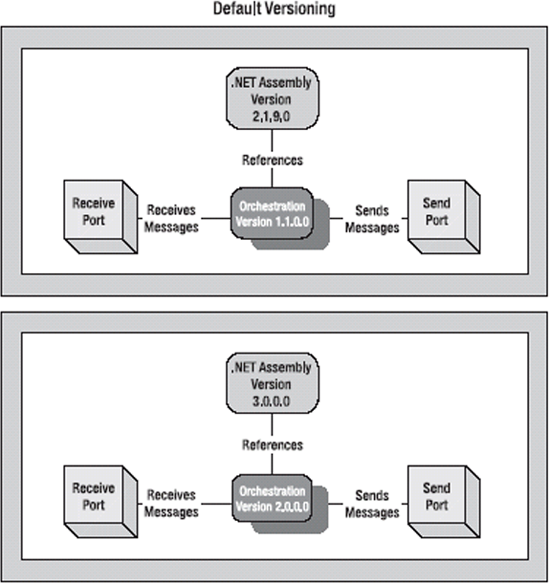
Following are some unique requirements for side-by-side deployments:
Provide an ability to deploy new releases.
Provide an ability to deploy incremental releases (without affecting previous deployments).
Provide an ability to deploy hot fixes (redeployment of recent deployment installs without affecting previous deployments).
To ease maintenance, stamp all assemblies with the same version.
Side-by-Side Deployment Strategies
To achieve side-by-side deployment, it is
necessary to ensure versioning is maintained appropriately between all
referenced assemblies. Without a versioning strategy, any side-by-side
deployment strategy is prone to errors. Within .NET, any assembly
references (either BizTalk or non-BizTalk) need to match the assembly
versions defined within referenced objects at compile time.
The default versioning schema causes a conflict
within the BizTalk environment. In a typical BizTalk environment, along
with the assemblies, you also have external objects like receive/ send
ports and schemas that are shared between different versions. Messages
meant for one version can be picked up and processed by another version,
which may lead to errors or undesired results.
To solve this problem, it becomes necessary to
extend .NET's versioning scheme for BizTalk. The following sections
describe three common strategies for doing this.
Versioned Deployment Using Versioned Receive/Send Ports
In this strategy, all receive port and send port
names are unique across multiple deployments.Hence any messages that
arrive at these ports are guaranteed to be processed by the specific
versioned modules that are listening to these specific ports. A diagram
of this approach is shown in Figure 2.
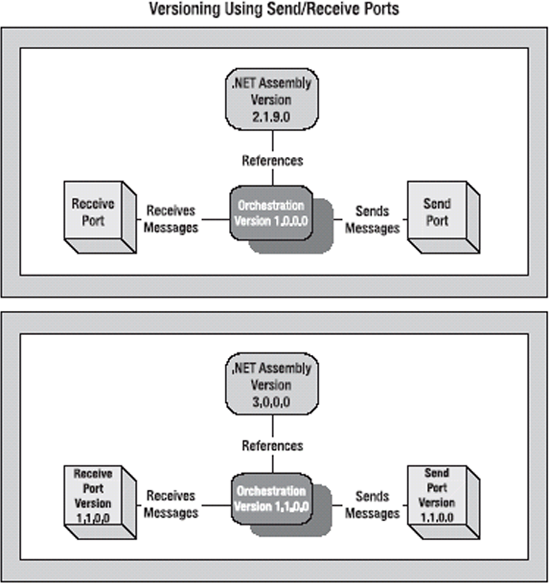
Following are the steps involved:
Update the assembly version defined within the specific BizTalk project.
Update the assembly version defined within the associated non-BizTalk assemblies.
Before
compilation, update each binding file associated with the BizTalk
modules with appropriate port names (port names will be suffixed with
the assembly version). If the binding step is included during
deployment, these ports will get created during deployment.
The advantages of this process are as follows:
The deployment strategy is clean.
Any number of deployments are guaranteed to process only those messages that arrive at specific binded ports.
Namespaces of associated schemas do not need to be changed.
The sole disadvantage is this:
For every release, all associated
receive/send ports will need to be updated to reflect the new version.
If external partners are submitting messages, new locations will need to
be communicated with external partners.
Versioned Deployment Using Versioned Schema Namespaces
This strategy involves changing the namespaces
associated with specific schemas. Changing a namespace is easily
accomplished by suffixing each schema's namespace with a specific
version number before compilation. This strategy solves the correlation
error encountered with the preceding approach and is diagrammed in Figure 3.
Performthe following procedure to deploy the assemblies in your project using versioned schema namespaces:
Update the assembly version defined within the specific BizTalk project.
Update the assembly version defined within the associated non-BizTalk assemblies.
Update all references for imports and includes within schemas if you have included any.
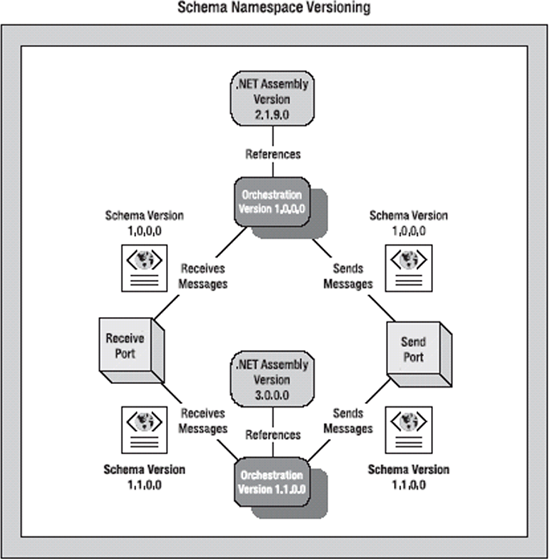
Following are the advantages of the versioned deployment approach:
As BizTalk distinguishes schemas based on
namespaces and root node, specific messages are processed by specific
versioned assemblies.
This process works in scenarios where correlation sets are initialized.
Receive/Send
port names do not need to be changed. This is beneficial in scenarios
where external partners are submitting messages to specific ports. Using
this approach, new port locations do not need to be communicated to
external partners.
Disadvantages of the versioned deployment approach include the following:
Namespaces of associated schemas should
be changed even if there are no structural changes to these specific
schemas. This is to ease the management of the schemas once they have
been deployed. For instance, it is much easier to examine a DLL and know
that all the schemas within it contain the same version. If not, the
management of the schemas can become cumbersome.
For
every release, all associated schema namespaces will need to be updated
to reflect the new version. This could constitute a significant
architectural change.
Combining the Two Approaches
You can combine the previous two approaches using
versioned schema namespaces in conjunction with versioned receive/send
ports. This approach is shown in Figure 4.
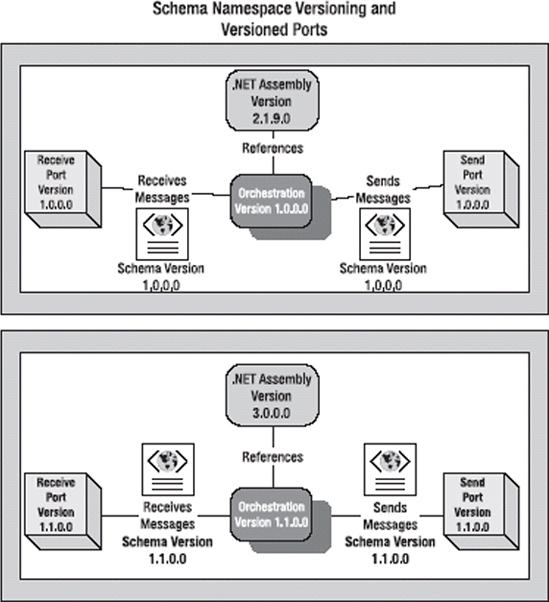
The steps involved in the combined approach are as follows:
Update the assembly version defined within the specific BizTalk project.
Update the assembly version defined within the associated non-BizTalk assemblies.
Update all references for imports and includes within schemas if you have included any.
Before
compilation, update each binding file associated with BizTalk modules
with appropriate port names (port names will be suffixed with assembly
version). These ports will be created if the binding step is included
during deployment.
Advantages of the combined approach are as follows:
It presents a cleaner deployment strategy and easier debugging scenarios.
As
BizTalk distinguishes schemas based on namespaces and root node,
specific messages are processed by specific versioned assemblies.
It works in scenarios where correlation is used.
And the disadvantages:
Namespaces of associated schemas need to be changed even if there are no structural changes to these specific schemas.
All receive/send port names also need to be changed.
For
every release, all associated schema namespaces as well as receive/send
ports will need to be updated to reflect the new version.
Versioned Deployment Using Filtering
This strategy involves promoting an element
within a message (e.g., version) that is used within the filter
associated with a Receive shape that gets activated when a message is
received by the orchestration. This has the benefit of allowing you to
use content-based routing information, which can be changed in a
production scenario with no code modification and very little downtime.
This approach is shown in Figure 5.
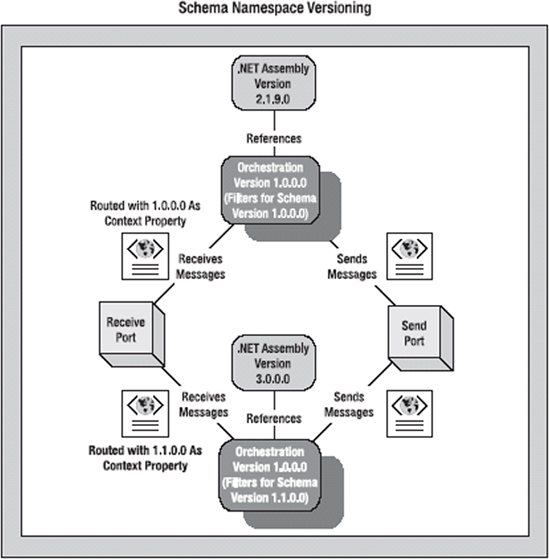
Use the following steps to implement this strategy:
Update the assembly version defined within the specific BizTalk project.
Update the assembly version defined within the associated non-BizTalk assemblies.
Before
compilation, programmatically update the filter expression to check for
specific data that contains version information (e.g., Message1.version
= "1.0.0.0"). A versionspecific message will get picked up by correct
versions and processed.
The advantages of this method are as follows:
Only filter expressions need to be updated.
Receive/Send port names do not need to be changed.
Schema namespaces do not need to be changed.
And the disadvantages:
It will not work for scenarios where
orchestrations are required to initialize a correlation set. If
correlation sets are being initialized and schemas of the same version
are being referenced between different deployments (different assembly
versions), BizTalk does not know which combination of assembly and
associated schema to use and generates a runtime error.
An element within the schema that contains the version number will need to be promoted.
For every release, this filter will need to be changed to reflect the current version.